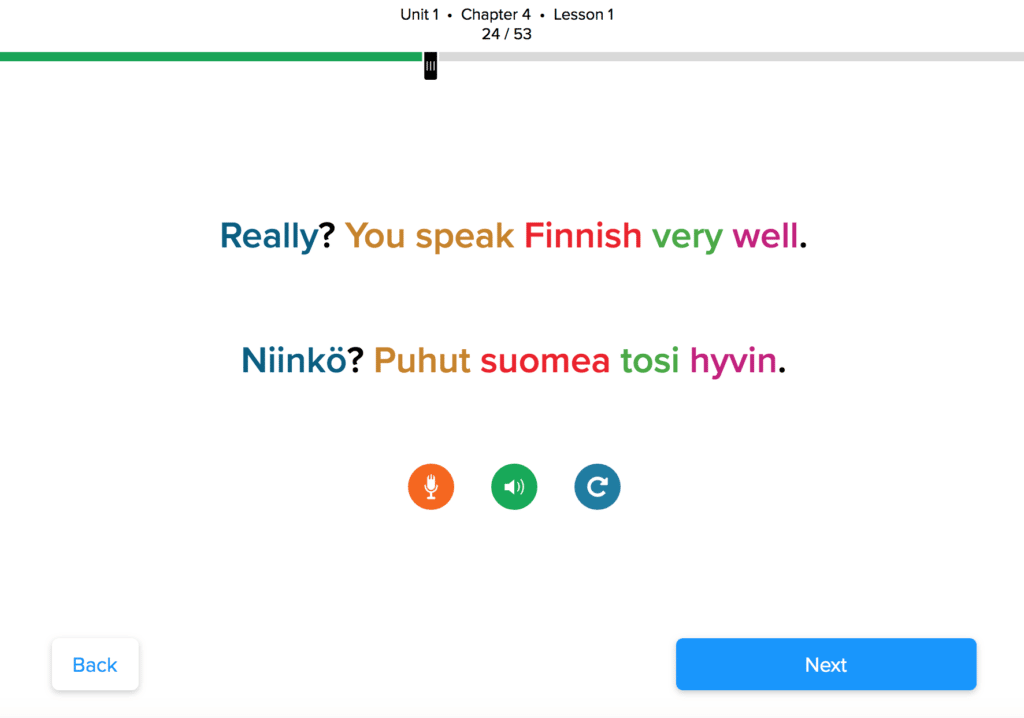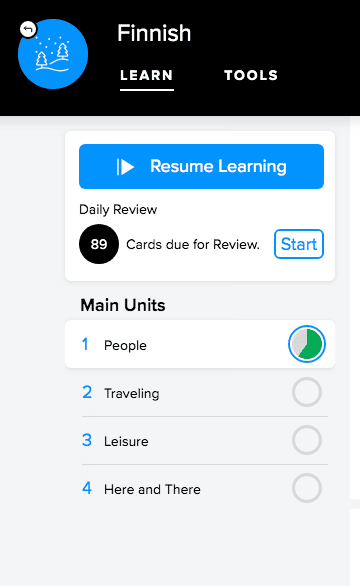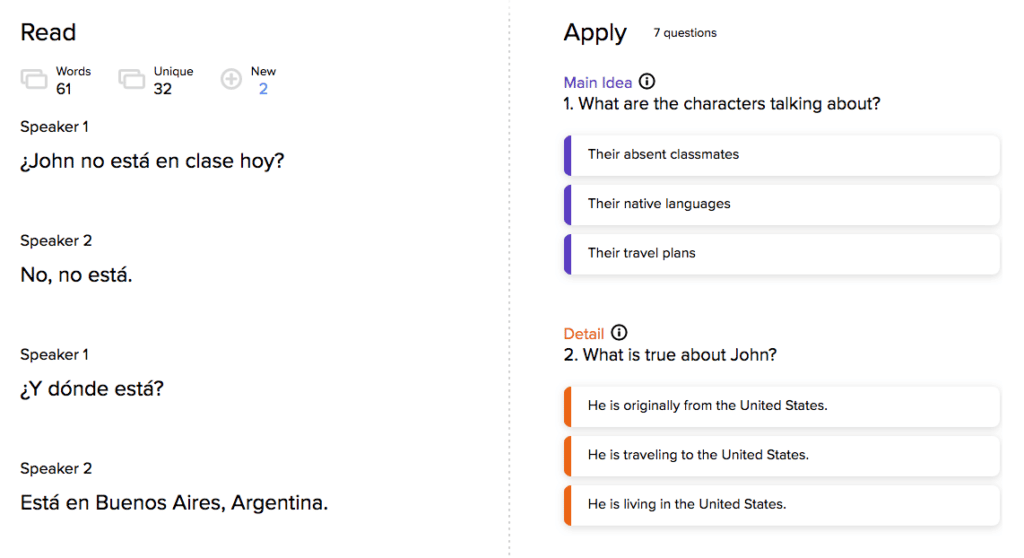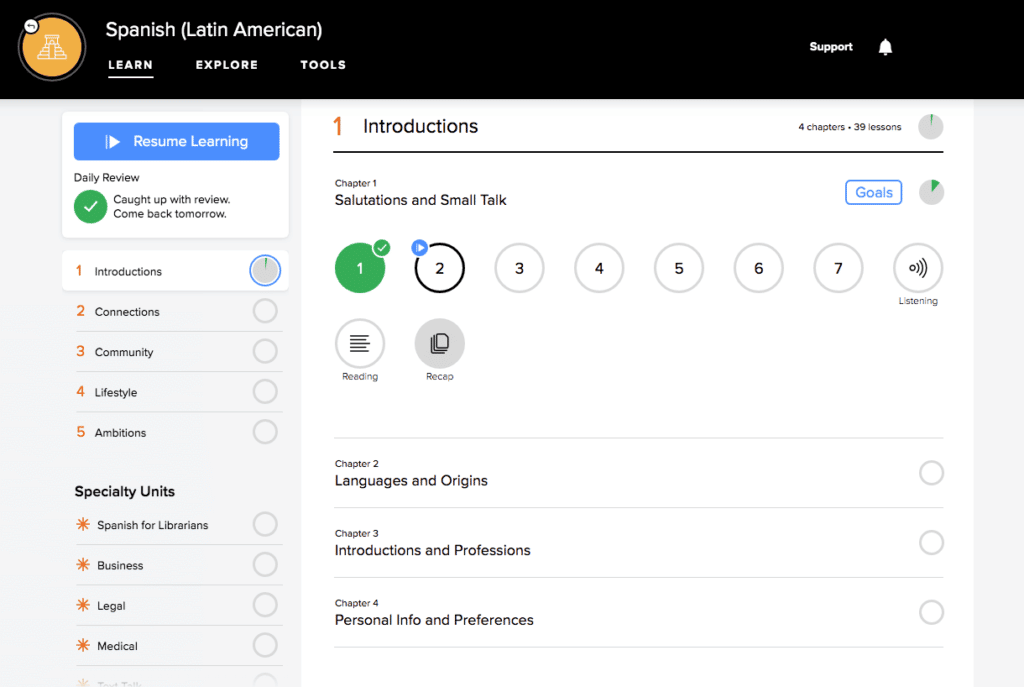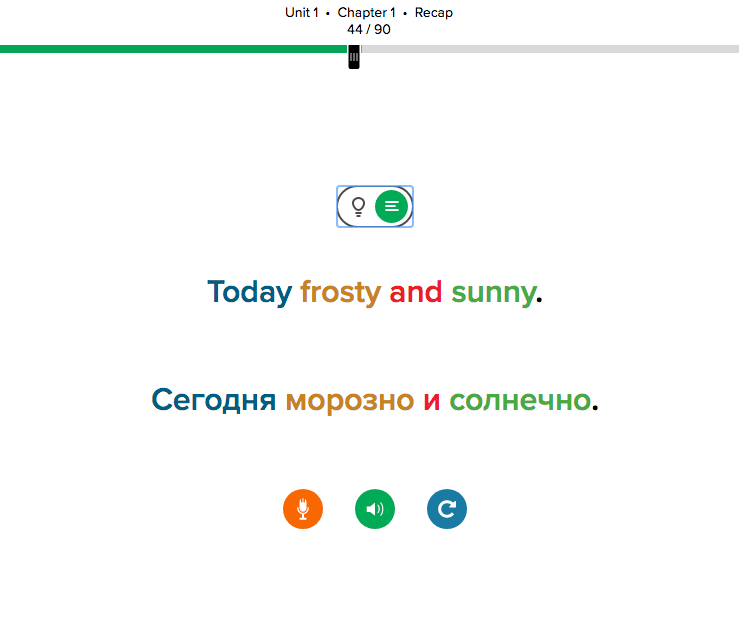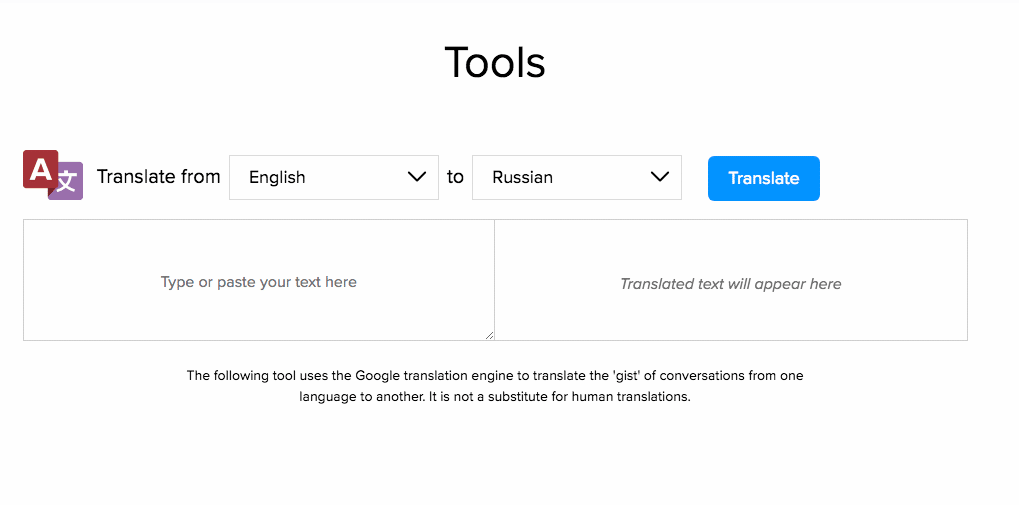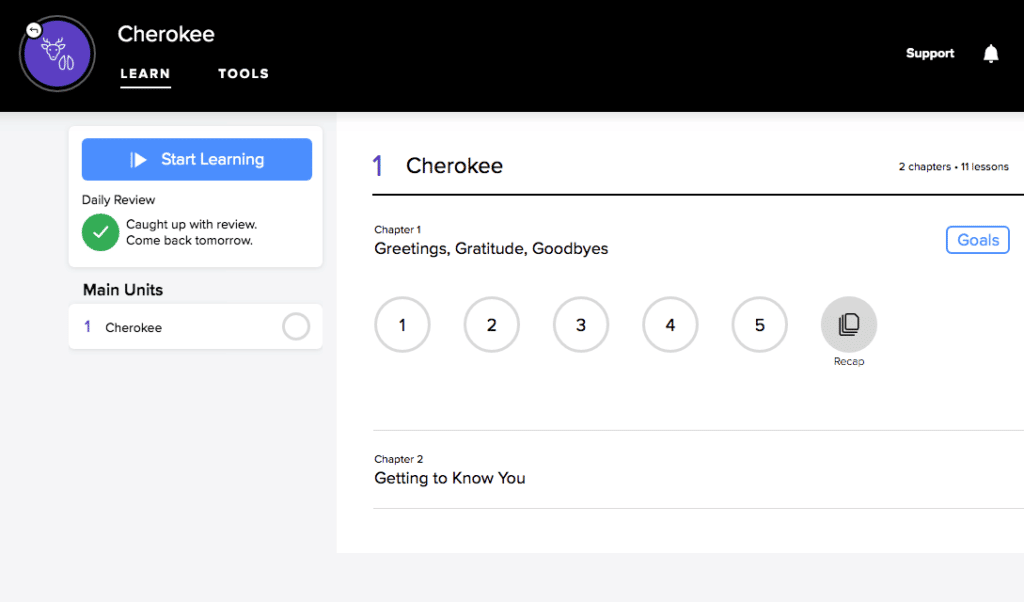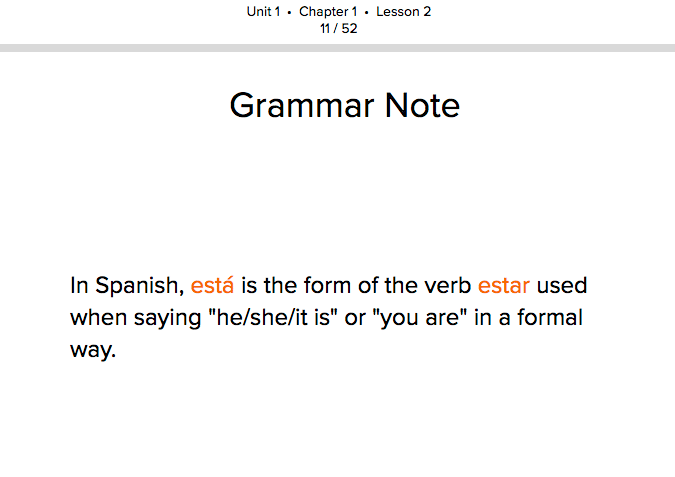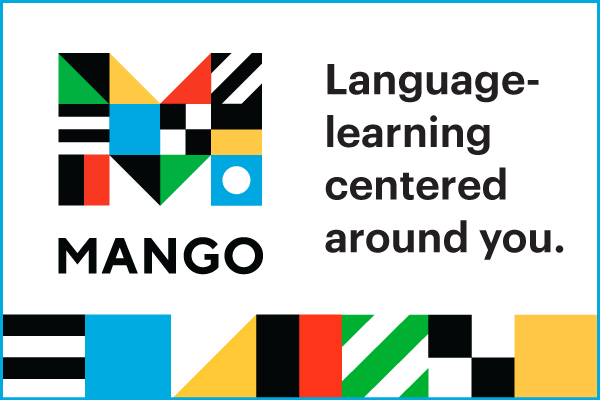
Our Mango Languages Review: Well Designed and Interactive but Needs More Images, Video and Advanced Content
Mango Languages is an online and mobile learning resource that’s said to evolve with you as you progress through the course. It’s not just self-paced language instruction, but a highly individualized learning experience that adapts to your study habits.
But has Mango actually delivered on that sweet promise, or has it turned sour in the process?
I used the program for several weeks for learning Latin American Spanish and Finnish, so I could find out the answer to this on my own.
Read my Mango Languages review and find out if the program is right for you.
Overview

Name: Mango Languages
Description: An award-winning program with a focus on organic language acquisition.
Languages offered: Over 70 languages including Spanish, Korean, Punjabi and many more, as well as specialties (romance, academic, business) and some unique options (Shakespearean English, Cherokee).
Offer price: Monthly subscription at $7.99/month or $79.99/year for one language; $17.99/month or $179.99/year for all languages; free through many public libraries
Summary
Mango Languages aims to help learners gain practical conversational skills through scientifically proven methodologies. While its methods do get repetitive, the ever-evolving program provides each user with a tailored route to learning a new language.
- User friendliness - 10/1010/10
- Delivers on promises - 10/1010/10
- Authenticity - 9/109/10
- Value for price - 9/109/10
Pros
- Interactive lessons that cover conversational and useful language and engage all four main language skills
- Beautiful and intuitive interface
- Reinforces and reviews content often to ensure you don’t forget it
- All audio features professionally recorded native speakers
- Includes some unique features like literal translations, authentic mini-movies and more
Cons
- Lack of images and video components
- Light content for minor languages
- Grammar content isn’t reinforced enough
- Over-repetition can prove tedious
- Lack of content for advanced language learners
Contents
- What Is Mango Languages?
- Mango Languages Subscription Options
- What Works Well in Mango Languages
- Unique Mango Languages Features and Functions
- What’s Missing from Mango Languages
What Is Mango Languages?
Mango Languages is an award-winning, language-learning platform based in Farmington Hills, Michigan. It was founded in 2007 by a team of four ambitious innovators who wanted to leverage technology to bring down linguistic and cultural barriers.
Mango’s goal is to help learners gain practical conversational skills through scientifically proven methodologies so you can rapidly transition from a non-speaker to someone who can hold meaningful interactions in a foreign tongue.
The folks behind Mango believe in organic language acquisition, so they created a product that doesn’t deal too heavily with grammar. Instead, the focus is placed on actual conversations, with grammar learned in the background.
This methodology came directly from Mango’s CEO Jason Teshuba and his own experiences learning Hebrew and Russian. He observed that as he progressed through conversations in his target languages, his intuition and feel for the language increased, and he learned grammar naturally.
Mango offers courses in over 70 languages, including the different regional branches of Arabic (Egyptian, Iraqi, Levantine and Modern Standard) and Spanish (Castilian and Latin American). There are also specialty language courses that focus on particular fields of work, such as Business Spanish, Medical Spanish and Legal Spanish, so there really are options for all sorts of language learning goals.
Remember Mango’s goal to leverage technology to break down cultural barriers? Well, if you want to learn specifically about culture, like the Irish St. Patrick’s Day or the German Oktoberfest, there are short courses about those, too!
And hey, if you or your friend are learning English, Mango Languages is one of the best sites that can get the job done—what with their English course being taught from over 20 source languages.
Mango Languages is available online and in app form for both iOS and Android devices. You can sync your progress across all devices for that seamless learning experience. So whether you’re on the go, in a coffee shop with your laptop or in bed with “night mode” turned on, you have Mango lessons on the ready.
Mango can not only be used individually but also for groups of people looking to learn together! Educators can use Mango Classroom as a 24/7 teaching assistant, helping to organize class activities and assessments. In fact, even global businesses and government agencies (like the military) have utilized Mango software to help employees and personnel get a better grounding in the language and culture of their international assignments.
So, with all that said, how well does Mango work?
This Mango Languages review will focus on the program as experienced by me, an individual language learner who was learning Spanish at the time.
Mango Languages Subscription Options
A subscription to Mango can be purchased for a set monthly fee, and there are three plan types to choose from. Learners can choose the subscription plan that works best for them and their goals.
Single Language
The simplest subscription option to Mango Languages allows learners to access course materials for a single language. That means that learners can choose whichever language they want to learn from the list of 70+ and watch their language level grow for an affordable monthly fee.
Monthly subscription fees are $7.99 for access to one language. If you pay for a year up front, you can save by paying $79.99.
With this plan, learners also get access to said language’s bonus courses and materials, an assessment and placement test (not available for all languages) and the Mango Movies feature, a program that lets you watch films in your target language (not available for all languages).
All Languages
Let’s just say that the Mango Languages “All Languages” plan is a polyglot’s dream!
It includes unlimited access to all the 70+ languages on offer. You’ll be asked to pick a language as a take-off point, but don’t worry: You can switch and explore other languages anytime you like.
The subscription for this option is $17.99 per month, or $179.99 if you pay for a year up front.
In addition to all the features available under the “Single Language” plan, you can create as many as five profiles for yourself and your family members or friends. So if you’re a family of language enthusiasts, or among like-minded friends, you can go ahead and learn languages together. Furthermore, your subscription includes 24/7 support, progress tracking and parental controls.
Free Library Subscription
The Mango Languages software is available for free to countless partner public libraries around the world.
Is your local library one of them? Head over to the Mango website to find out. At this link, you’ll be able to search the Mango system by typing either the name of your library, the city or the zip code of your location.
If you happen to have an account with a library that offers Mango Languages, you can have free access to the program ‘til the cows come home.
What Works Well in Mango Languages
Interactive Lessons
The standard Mango course consists of four or more “Units.” Each unit is broken up into “Chapters” and the chapters are further subdivided into “Lessons.” Major languages like English and Spanish have more content than others, compared to, say, Norwegian.
I tried using Mango to teach me two languages. I chose Latin American Spanish because I knew it would be one of the most developed courses on the Mango Languages platform as well as Finnish because of its status as a lesser-studied language.
Right off the bat, I noticed that each lesson hits on the four main language skills: listening, reading, writing (typing) and most importantly, speaking. The lessons are interactive and come in the form of a slide deck, with each lesson containing 20 or more slides to run through.
Lessons usually open with a dialogue containing target words and phrases. These are then presented in bits and pieces, with each subsequent slide adding more concepts and complexity to your understanding of the original dialogue.
Each screen involves some sort of activity or drill. It can be as easy as listening to how a new word is pronounced or a sorting task where you craft a sentence by rearranging words.
The slides build on previous ones. What I liked is that the program took me through individual words before I was thrown into phrases, sentences and conversations. In fact, the experience was often so seamless that I rarely even noticed that each word was giving me the building blocks to create a full thought as well as the tools to create spontaneous sentences on my own.
Every now and then, small cultural or grammar notes landed in my lap and helped me get a firm grounding on the concepts presented. Sometimes, a picture or two might appear in order to illustrate a point.
Going through each deck and working on the drills is said to increase your linguistic intuition and comprehension.
Beautiful and Intuitive Interface
One of Mango’s main strengths is its sleek interface. The screen features fonts, colors and designs that are easy on the eyes and light on the mind. And the team has recently (in 2019) updated the software for an even more intuitive and streamlined experience, and it has really paid off.
Your dashboard gives you a well-thought-out layout of everything you’d want to do with Mango. There you can access lesson progress and review prompts under the “Learn” menu, as well as translation and dictionary tools under the “Tools” menu.
The color-coding it employs in every lesson is a winner, too. There’s a correspondence between the font colors used for sample sentences and their English translations. This made it easy to understand word-by-word translations and practice correct word order in my target languages.
For example, if the verb in the Finnish sentence is in brown, its corresponding English verb will also be in brown. This made it easy for me to intuit, without explicit grammar rules, how the elements in the sentences translate from one language to another.
Recaps, Reviews and Reinforcements
Repetition is central to the entire Mango Languages learning system. Mango works with spaced repetition technology so it can tailor the lessons and review segments to your needs. I noticed that when I missed a word, the program identified it as a “weak spot.” The software’s algorithm then ensured that I got to work with that word a little bit more, so it came up later in the lesson.
In addition to the repetitions and drills in the lesson itself, there are reinforcement exercises in each chapter and unit. These make sure that the goals shown at the beginning of every lesson have been successfully integrated by the student.
In fact, everything in the lessons and Daily Reviews is “triple-layered.” This means that you’ll always have the word, phrase or sentence in lively fonts and colors, its English translation and the audio pronunciation.
The dashboard, which gives you everything you need to know at a single glance, shows your progress through the course so you can immediately pick up where you left off. The fact that you can also synchronize across devices means you won’t have any problems doing so.
Also, when I logged into Mango Languages the second day of trying it out, I was surprised to discover that the adaptive algorithms in place ensured that I received daily review prompts. These were very relevant to my learning needs, and Mango Languages had me review Finnish content that I had encountered during my initial sessions.
Working with Native Speakers
Mango courses are developed by expert linguists and passionate native speakers who pronounce the words, phrases and sentences, and who animate the conversations and dialogues in the lessons. The audio is the result of professionally-produced and studio-recorded sessions that ensure crisp and clear inputs. This is rare in many popular online language learning programs, but in both the languages I tried out, the native audio was superb.
If at any time during the lesson you need to hear what a word or phrase sounds like, you merely click or tap the green speaker icon, which you always find dead-center on your screen.
You can practice your own pronunciation by tapping on the orange microphone icon found next to the speaker icon. You can actually compare your recorded wave patterns to those of Mango experts. (The closer in form your wave patterns are to a native speaker’s, the better!)
Lessons Are Conversational & Topical
With Mango, you’re not just a passive recipient of information. The lessons get you to do something, engaging you to work actively with words and phrases—letting you manipulate their order in a sentence, prompting you to speak into the microphone or letting you in on a native speaker’s conversation.
Mango lets you learn organically by practicing listening, reading, writing and speaking in the target language. In fact, these are the same skills crucial for preparing you to have your own conversations in your target language, but not just any conversation: conversations that you are likely to have.
Mango excels in teaching language that is topical and useful. Instead of memorizing out-of-context grammar rules or impractical vocabulary related to topics that you won’t ever use, Mango gets right to the point.
In fact, I learned how to talk about myself and my family within the first couple of lessons in both Latin American Spanish and Finnish, and later lessons had me asking for directions, ordering food, going shopping and navigating a foreign locale.
These topics are necessary for creating a solid base in any language.
Robust Content for Many Languages
For major languages, like English and Spanish, there’s plenty of content to pick up. You can easily spend 80-100 hours learning the target language. For example, in Mango’s Latin American Spanish course, there are five main units with a total of 41 chapters, as well as six specialty courses, including Business, Legal and Medical Spanish and three Mango Movies.
Better yet, Mango is continually adding lessons to their lineup so the units will only get better with time.
Even for non-major languages, Mango offers enough content to get a good basis in the language. For example, Mango Languages is one of the only language learning programs to offer Kazakh, Haitian Creole and indigenous languages such as Cherokee and Potawatomi.
Unique Mango Languages Features and Functions
While previous highlights focused on standard features that may be found in many other language courses, Mango Languages has a couple of features that are almost completely unique to its program.
Literal and Dynamic Translations
There are many words and phrases in languages that don’t have direct or meaningful translations into other languages.
Idiomatic expressions are fertile grounds for these. The Spanish phrase estar como una cabra literally means “to be like a goat.” This could mean anything, from smelling like one to exclusively eating greens. The phrase actually means “to be a little crazy.”
Instead of divining a phrase’s meaning from the heavens, Mango gives you both the literal equivalent of the words and also their intended meaning. That way, you can avoid getting a little crazy!
Even with sentences that are not idiomatic, having a literal and dynamic translation can help you learn word order and get one-to-one correspondence between the words you’re learning in your target language and what they mean in English.
Google Translate Integration
Though far from perfect, Google Translate is the big daddy of the translation game.
Mango Languages integrates well with Google Translate. Thanks to this, you can fetch the translation for practically any word using what’s probably the most advanced translation platform available today. Simply click on the “Tools” menu for any language and get an instant translation for any word, sentence or longer text.
What’s Missing from Mango Languages
An honest review of Mango Languages can’t just highlight its successes. Here’s a straightforward look at what didn’t work for me.
Light Content for Minor Languages
To be fair, this is probably not just an issue for Mango, but for major language companies that offer a wide array of languages, in general. It’s often the case that popular languages get a disproportionate investment in course development compared to the less popular ones.
For example, I’ve already mentioned that Mango Language’s Latin American Spanish course is quite extensive compared to a minority language like Cherokee, which has merely 11 lessons over one unit. We can safely say that Mango Languages simply can’t be the sole language-learning resource for someone wanting to learn a lesser-known language.
Grammar Content Could Be Reinforced
Because of Mango’s belief in organic language acquisition, you’ll realize that there’s not a lot of grammar instruction in the program, save for some insightful grammar notes.
For example, I noticed that there are “Grammar Notes” included in the Mango lessons, but they are quite limited on the details, and once they are passed, there is no way to access that information again unless you redo the entire lesson.
For those who want an explicit, point-by-point tutorial on rules of grammar, you might want to look somewhere else—or at least take your own notes when the skimpy Mango grammatical explanations do show up.
Over-repetition Can Prove Tedious
While repetition is central to Mango’s approach, the drills can get boring, especially for courses that are missing some of the more hands-on features, such as listening and reading exercises or Mango Movies.
For some learners, myself included, working with the same words and phrases over and over, especially in the earlier lessons, can get too monotonous, and learners can start to crave more interesting material and methods. Furthermore, they may not be encouraged to progress.
So don’t forget to take a break from Mango Languages and employ a number of different study methods.
Lack of Content for Advanced Language Learners
Mango Languages is a good learning resource if you’re an absolute beginner in the language you’re interested in, but if you’re an advanced student in need of more complex stimulation, Mango isn’t for you. Lessons usually cap off at the intermediate (B1/B2) level.
Even still, Mango never brings you past the word and sentence recall method, so learners never use the language spontaneously nor do they get to use it in longer spoken or written contexts.
Sure, finishing a Mango course makes you knowledgeable about the language—not native speaker-fluent, but you’ll be able to navigate a foreign country adeptly—but just don’t expect the course to take you to complete fluency.
As we’ve been suggesting throughout this post, Mango works best as part of a whole cocktail of books, audiobooks, language courses, and one-on-one tutoring that you should get yourself into.
Lack of Images and Video Components
Mango Languages started with very few images to bolster their lessons. Having these elements embedded in the lessons would bolster the program’s effectiveness, especially for the more visually-oriented learners. Although the text is admittedly lively and colorful, some might not find the content to be engaging enough.
To add more visual components to your studies, FluentU is an additional language learning app that pairs well with Mango Languages.
With FluentU, you hear languages in real-world contexts—the way that native speakers actually use them. Just a quick look will give you an idea of the variety of FluentU videos on offer:

FluentU really takes the grunt work out of learning languages, leaving you with nothing but engaging, effective and efficient learning. It’s already hand-picked the best videos for you and organized them by level and topic. All you have to do is choose any video that strikes your fancy to get started!
Each word in the interactive captions comes with a definition, audio, image, example sentences and more.
Access a complete interactive transcript of every video under the Dialogue tab, and easily review words and phrases from the video under Vocab.
You can use FluentU’s unique adaptive quizzes to learn the vocabulary and phrases from the video through fun questions and exercises. Just swipe left or right to see more examples of the word you're studying.

The program even keeps track of what you’re learning and tells you exactly when it’s time for review, giving you a 100% personalized experience.
Start using the FluentU website on your computer or tablet or, better yet, download the FluentU app from the iTunes or Google Play store. Click here to take advantage of our current sale! (Expires at the end of this month.)
Here’s what we recommend: Learn a few new words or phrases on Mango Languages. Then, reinforce those words and images through visually appealing content. It’s a win-win.
So, after all that’s been said and done, was Mango Languages able to deliver on its promise?
I’d say so.
In fact, Mango Languages can give you a personalized and tailored route to learning a new language.
As a product, Mango has a bright future still ahead. The Mango staff is continually learning and adapting, bringing in more features and functionalities to their system.
Something tells me we haven’t seen the last iteration of this variety of Mango.
Download: This blog post is available as a convenient and portable PDF that you can take anywhere. Click here to get a copy. (Download)


